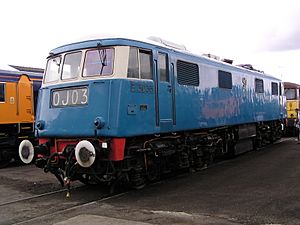British Rail Class 83 facts for kids
The Class 83 electric trains were special locomotives built for British Rail. They were designed to pull passenger and freight trains on the West Coast Main Line. These powerful trains helped make railway travel faster and more modern.
Quick facts for kids British Railways AL3British Rail Class 83 |
|
 |
|
| Class 83, no. E3035, on display at Doncaster Works open day on 27th July 2003. This locomotive is preserved by the AC Locomotive Group at Barrow Hill Engine Shed. | |
| Power type | Electric |
|---|---|
| Builder | English Electric at Vulcan Foundry |
| Build date | 1960–1962 |
| Total production | 15 |
| Configuration | Bo-Bo |
| UIC classification | Bo'Bo' |
| Gauge | 4 ft 8 1⁄2 in (1,435 mm) |
| Wheel diameter | 4 ft 0 in (1.219 m) |
| Length | 52 ft 6 in (16.00 m) |
| Weight on drivers | 19 long tons (19 t) |
| Locomotive weight | 76.40 long tons (77.63 t) |
| Electric system(s) | 25 kV AC |
| Current collection method | Pantograph |
| Traction motors | 740 hp (550 kW) English Electric 532A, 4 off |
| Top speed | 100 mph (160 km/h) |
| Power output | 2,950 hp (2,200 kW) 2200 kW (continuous) |
| Tractive effort | 38,000 lbf (169 kN) 169 kN (max) |
| Train heating | Electric Train Heating |
| Train brakes | Vacuum, Dual from 1972–1973 |
| Career | British Rail |
| Class | AL3; later 83 |
| Number | E3034–E3035, E3097, E3098, E3100; later 83001–83015 |
| Axle load class | Route availability 6 |
| Retired | 1975 (1), 1978 (1), 1983 (10), 1989 (3) |
| Disposition | One preserved, remainder scrapped |
Contents
What is the Class 83?
The Class 83 was a type of electric locomotive. It was built for British Rail in the early 1960s. These trains were part of a big plan to make train travel better. They helped electrify the main railway lines.
Why Were They Built?
These locomotives were created for the West Coast Main Line. This is a very important railway line in Britain. The goal was to switch from steam and diesel trains to electric ones. Electric trains are often faster and cleaner.
Building These Electric Giants
The Class 83 locomotives were built by English Electric. They were made at the Vulcan Foundry in Newton-le-Willows. This company was famous for making powerful engines.
How Many Were Made?
Only 15 of these special locomotives were built. They were made between 1960 and 1962. Each one was given a unique number. Their original numbers started with 'E'. Later, they were renumbered to start with '83'.
How They Worked
The Class 83 trains were electric. This means they got their power from overhead wires. A special arm on the roof, called a pantograph, collected the electricity.
Speed and Power
These locomotives were quite fast for their time. They could reach speeds of up to 100 mph (160 km/h). They had a lot of power, about 2,950 hp (2,200 kW). This allowed them to pull heavy trains.
What is a Bo-Bo?
The Class 83 had a wheel arrangement called 'Bo-Bo'. This means it had two bogies (wheel sets). Each bogie had two powered axles. This design helps the train move smoothly. It also helps it grip the tracks well.
Their Time on the Tracks
The Class 83 locomotives worked on the West Coast Main Line. They pulled both passenger and freight trains. They were an important part of modernizing British railways.
When Did They Stop Running?
These trains served for many years. However, newer and more advanced trains were eventually built. The Class 83s started to be retired in the mid-1970s. The last ones were taken out of service by 1989.
Where Are They Now?
Most of the Class 83 locomotives were scrapped. This means they were taken apart for their materials. But one special locomotive was saved!
The Preserved Class 83
One Class 83, number E3035 (later 83012), was preserved. It is now looked after by the AC Locomotive Group. You can sometimes see it on display at places like Barrow Hill Engine Shed. It helps people learn about railway history.
Images for kids
-
E3035, on display at Doncaster Works open day on 27 July 2003. This locomotive is preserved by the AC Locomotive Group at Barrow Hill Engine Shed.



